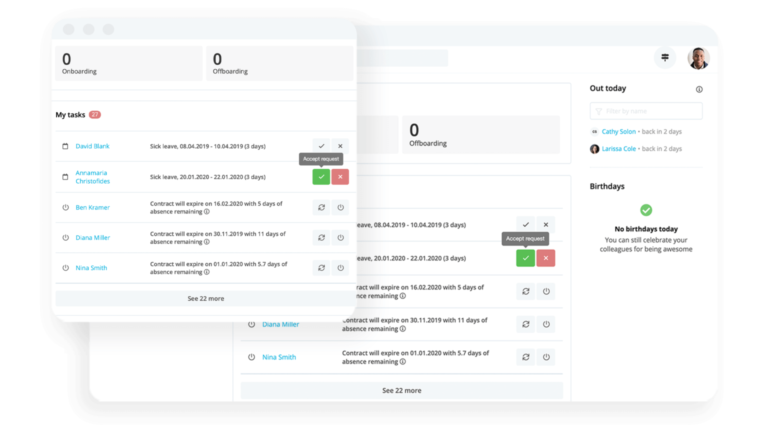Knowledge Management (KM): Fully Explained

Taking advantage of all the knowledge, expertise, and ideas within an organisation is a key part of maximising results, and knowledge management can help you do it.
In this article, you’ll learn:
What knowledge management is and its benefits
How knowledge management systems can be used to implement your strategy
Why knowledge management is important and best practices to do it right
Contents
- 1What is Knowledge Management?
- 2The Top Benefits of Knowledge Management
- 3What are Knowledge Management Systems?
- 4What is a Knowledge Management Strategy?
- 5Why Does Knowledge Management Matter?
- 6Knowledge Management Best Practices
- 7Frequently Asked Questions: Knowledge Management
- 8Knowledge Management Made Easy with Personio
What is Knowledge Management?
Knowledge management (KM) is the process of defining, creating, organising, retaining, and sharing information assets within an organisation. When done properly, KM involves maintaining knowledge in an easily accessible place and can transform the success of an organisation’s operations.
The Top Benefits of Knowledge Management
When knowledge management is done properly, a variety of benefits can be achieved in an organisation:
Improved decision-making – When employees have access to all the knowledge within the larger organisation, they can make better (and faster) decisions.
Speed up knowledge access – Proper KM strategies and tools can improve not only the amount of knowledge available to employees, but the speed at which they can find it. (This is also helpful for ramping up new hires.)
Promote innovation – With a culture of sharing information, ideas, knowledge, and skills, employees are more likely to innovate and collaborate to create valuable change.
Boost customer satisfaction – According to Econsultancy, 31% of customers want instant online help and 40% expect to receive assistance in less than 5 minutes. Collaboration and KM will help teams meet those expectations, increase value for customers, and decrease the time it takes them to get answers or improvements.
Avoid redundancy – Why repeat a task or lesson if it’s been done or learned already? KM enables employees to learn from each other and avoid redundant work.
What are Knowledge Management Systems?
Knowledge management systems (KMS) are tools that enable people to store, manage, and retrieve the information within an organisation. These systems make it easier to extract the benefits of KM listed above.
Depending on the needs of your organisation, there will be different types of information captured in your KMS:
Documents
Document management systems are a kind of like a digital filing cabinet: a centralised repository for all the digital documents that might be needed within the organisation, from company handbooks to benefits to calendars and more. When documents are easily retrievable, it makes employees and workflows more efficient and ensures knowledge is not lost.
These systems can also increase security with backup procedures and by making certain documents password-protected or only accessible to specified employees.
Organisational data
If an employee needs to find information about the organisation – e.g. org charts, information on the brand, employee contact information, contracts, etc. – they should be able to access it in the KMS.
Team data
Information relating to the team that an employee may need could include strategy documents, presentation guidelines, competitor research, timelines for new products, or process best practices.
Organisational news
The KMS is also a good place to store news relating to the organisation. You could store All-Hands meeting notes or recordings, updates from key departments like IT and HR, promotions and media mentions to be aware of, and the latest information on customer satisfaction metrics like NPS.
Full focus for your HR strategy

Whether personnel administration, payroll, or recruiting: Personio automates core HR processes, simplifying your overall work. Now, you’ve got more freedom to tackle important topics, like an HR strategy.
How Personio WorksWhat is a Knowledge Management Strategy?
A knowledge management strategy is an organisation’s plan of action for how to manage, centralise, and disseminate information to improve efficiency and knowledge sharing.
When building your knowledge management strategy, think about questions like:
How can we make knowledge sharing as easy as possible?
What repeatable processes can we put in place?
How can we develop a strategy that will create a culture of learning and knowledge sharing?
Who will be in charge of each area within the KMS?
Should we reward people for knowledge “creation” (i.e. adding to our KMS)?
How do we encourage employees to actually use our KMS?
Why Does Knowledge Management Matter?
Knowledge management is important because it enables an organisation to improve efficiency, make better and faster decisions, and ensure employees have access to information that will help them do their jobs. In turn, a smarter workforce is created, leading to better outcomes for the employees, the company, and the customers.
According to a 2020 study by Deloitte, 75% of surveyed organisations say “creating and preserving knowledge across evolving workforces is important or very important for their success over the next 12–18 months, but only 9 percent say they are very ready to address this trend.”
In other words, a majority of organisations understand the importance of KM, but there is an extreme readiness gap as most are unprepared to address it.
Knowledge Management Best Practices
As you implement your knowledge management strategy or set up a KMS, here are some best practices to keep in mind:
Identify problem areas – If you understand the challenges being faced by employees in your organisation, you can pinpoint the knowledge gaps that need to be addressed.
Think about user experience – Having a huge stockpile of information is great, but it’s only helpful if people use it. Think through how the end users (i.e. employees) will interact with the KMS and ensure the information you provide is diversified and easy to consume.
Measure and scale – It can be difficult to measure the success of a knowledge management program, but tracking metrics (e.g. time to find an answer, number of views by users) can help successfully scale the initiative over time.
Frequently Asked Questions: Knowledge Management
What Are the Types of Knowledge Management?
Knowledge management can involve compiling, organising, and disseminating several types of knowledge:
Explicit – Knowledge that is easy to document (in writing)
Implicit – Learned skills or applied knowledge
Tacit – Intangible knowledge that is difficult to explain; obtained through personal experience
These are the three main types of knowledge involved in KM, but other types include Declarative, A Posteriori, A Priori, and Procedural knowledge.
What Is the Purpose of Knowledge Management?
The purpose of knowledge management is to save and share knowledge, ideas, and experience within an organisation to improve efficiency and decision-making.
What Are the Principles of Knowledge Management?
There are a wide range of principles of knowledge management depending on who you ask, but some of the most discussed are:
Knowledge is a valued asset
Knowledge requires the right environment to thrive
Knowledge is captured where possible and necessary
Knowledge should be freely sought and shared
The value of knowledge increases with re-use
Knowledge is the underpinning of an individual’s learning
Knowledge is the underpinning of organisational learning
Knowledge Management Made Easy with Personio
Ensure your knowledge management strategy covers the People side with Personio’s Digital Employee File. Built right into the Personio platform, this makes it easy to store all employee data and documents in digital personnel files that only need to be maintained in one place.

